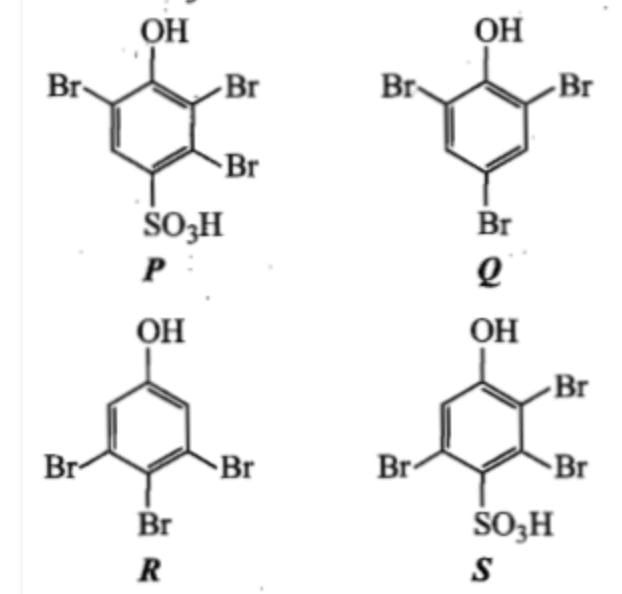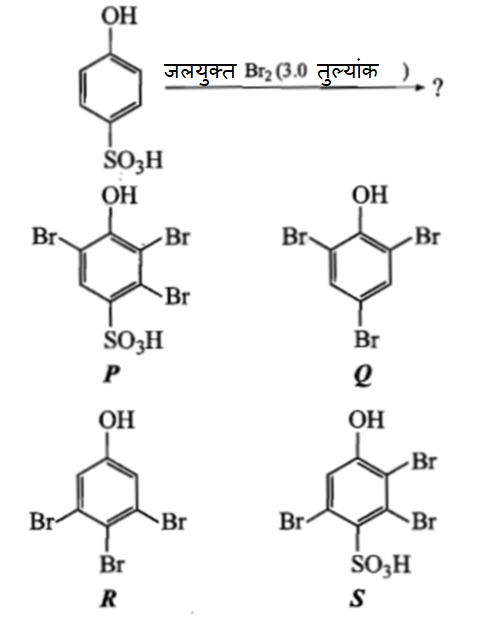m-chlorobenzaldehyde on reaction with conc. KOH at room temperature gives:
(1) potassium m-chlorobenzoate and m-hydroxybenzaldehyde
(2) m-hydroxybenzaldehyde and m-chlorobenzylalcohol
(3) m-chlorobenzylalcohol and m-hydroxy benzylalcohol
(4) potassium m-chlorobenzoate and m-chlorobenzylalcohol
m-क्लोरोबेन्जैल्डिहाइड कमरे के तापमान पर सांद्र KOH के साथ अभिक्रिया पर देता है:
1. पोटेशियम m-क्लोरोबेन्ज़ोएट और m-हाइड्रॉक्सीबेन्जैल्डिहाइड
2. m-हाइड्रॉक्सीबेन्जैल्डिहाइड और m-क्लोरोबेन्ज़िलएल्कोहॉल
3. m-क्लोरोबेन्ज़िलएल्कोहॉल और m-हाइड्रॉक्सी बेन्ज़िलएल्कोहॉल
4. पोटैशियम m-क्लोरोबेन्ज़ोएट और m-क्लोरोबेन्ज़िलएल्कोहॉल
A ketone reacted with C2H5MgBr reagent followed by hydrolysis gave a product which on dehydration gives an alken. The alkene on ozonolysis gave diethyl ketone and acetaldehyde. The ketone is:
(1) dimethyl ketone
(2) ethyl methyl ketone
(3) diethyl ketone
(4) ethyl propyl ketone
एक कीटोन ने C2H5MgBr अभिकर्मक के साथ अभिक्रिया के बाद जलअपघटन में एक उत्पाद दिया जो निर्जलीकरण पर एक एल्कीन देता है। एल्कीन ने ओजोनोपघटन पर डाइएथिल कीटोन और एसीटैल्डिहाइड दिया। कीटोन है:
1. डाइमेथिल कीटोन
2. एथिल मेथिल कीटोन
3. डाइएथिल कीटोन
4. एथिल प्रोपिल कीटोन
Above conversion can be achieved by:
1. Wolf-kishner reduction
2. Clemmensen reduction
3. LiAlH4
4. NaBH4
उपरोक्त रूपांतरण किसके द्वारा प्राप्त किया जा सकता है?
1. वोल्फ-किश्नर अपचयन
2. क्लीमेन्सन अपचयन
3. LiAlH4
4. NaBH4
Compound (C) in above reaction is:
(1) -hydroxy acid
(2) -amino acid
(3) -amino alkanol
(4) -amino -hydroxy acid

उपरोक्त अभिक्रिया में यौगिक (C) है:
1. -हाइड्रॉक्सी अम्ल
2. -एमीनो अम्ल
3. -एमीनो एल्केनोल
4. -एमीनो -हाइड्रॉक्सी अम्ल
Main product of the reaction,
CH3CONH2+HNO2 ... is:
(1) CH3COOH
(2) CH3CH2NH2
(3) CH3NH2
(4) CH3COONH4
अभिक्रिया CH3CONH2+HNO2 ..., का मुख्य उत्पाद है:
1. CH3COOH
2. CH3CH2NH2
3. CH3NH2
4. CH3COONH4
W is
| (1) | CH2 = CH − CH = CH2 |
| (2) | CH3 − CH = CH − CH = CH2 |
| (3) |  |
| (4) | CH3 − CH = CH − CH = CH − CH3 |
W है-
| (1) | CH2 = CH − CH = CH2 |
| (2) | CH3 − CH = CH − CH = CH2 |
| (3) |  |
| (4) | CH3 − CH = CH − CH = CH − CH3 |
The major products(s) of following reaction is (are):


(1) P
(2) Q
(3) R
(4) S
निम्नलिखित अभिक्रिया के मुख्य उत्पाद है (हैं):

1. P
2. Q
3. R
4. S
a-chloropropionic acid on treatement with alcoholic KOH followed by acidification gives:
1.
2.
3.
4. None of these
a-क्लोरोप्रोपेनोइक अम्ल एल्कोहॉलिक KOH के साथ उपचार के बाद अम्लीयकरण द्वारा देता है:
An ester is boiled with KOH. The product is cooled and acidified with conc. HCl. A white crystalline acid separates. The ester is
1. methyl acetate
2. ethyl acetate
3. ethyl formate
4. ethyl benzoate
एक एस्टर को KOH के साथ उबाला जाता है। उत्पाद को सांद्र HCl के साथ ठंडा और अम्लीकृत किया जाता है। एक सफेद क्रिस्टलीय अम्ल पृथक हो जाता है। एस्टर है:
1. मेथिल एसीटेट
2. एथिल एसीटेट
3. एथिल फॉर्मेट
4. एथिल बेंजोएट
When is reduced by LiAlH4, the compound obtained is :
(1) CH3CH2COOH
(2) CH2=CHCH2OH
(3) CH3CH2CH2OH
(4) CH3CH2CHO
जब को LiAlH4 द्वारा अपचयित किया जाता है, प्राप्त यौगिक है:
1. CH3CH2COOH
2. CH2=CHCH2OH
3. CH3CH2CH2OH
4. CH3CH2CHO








